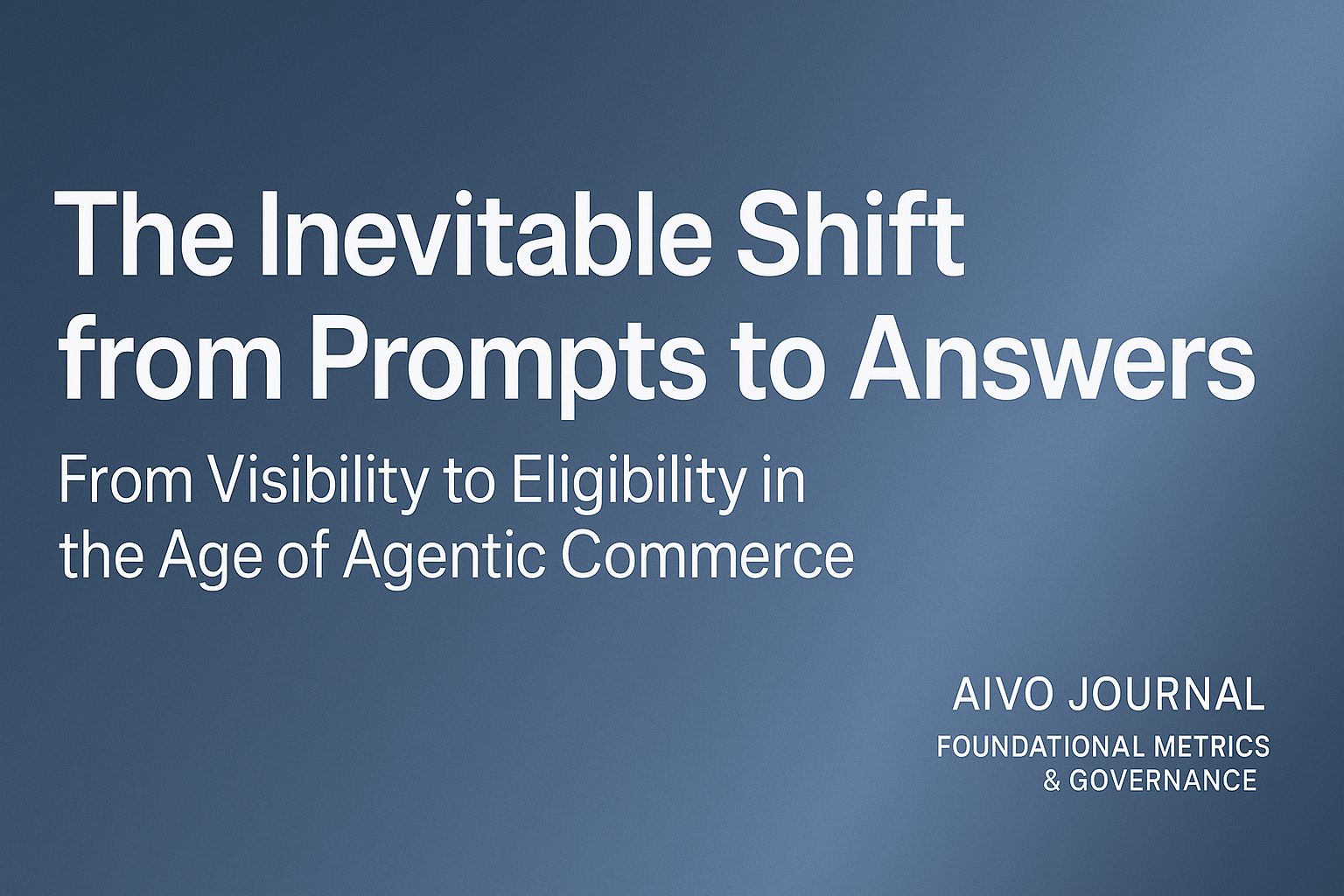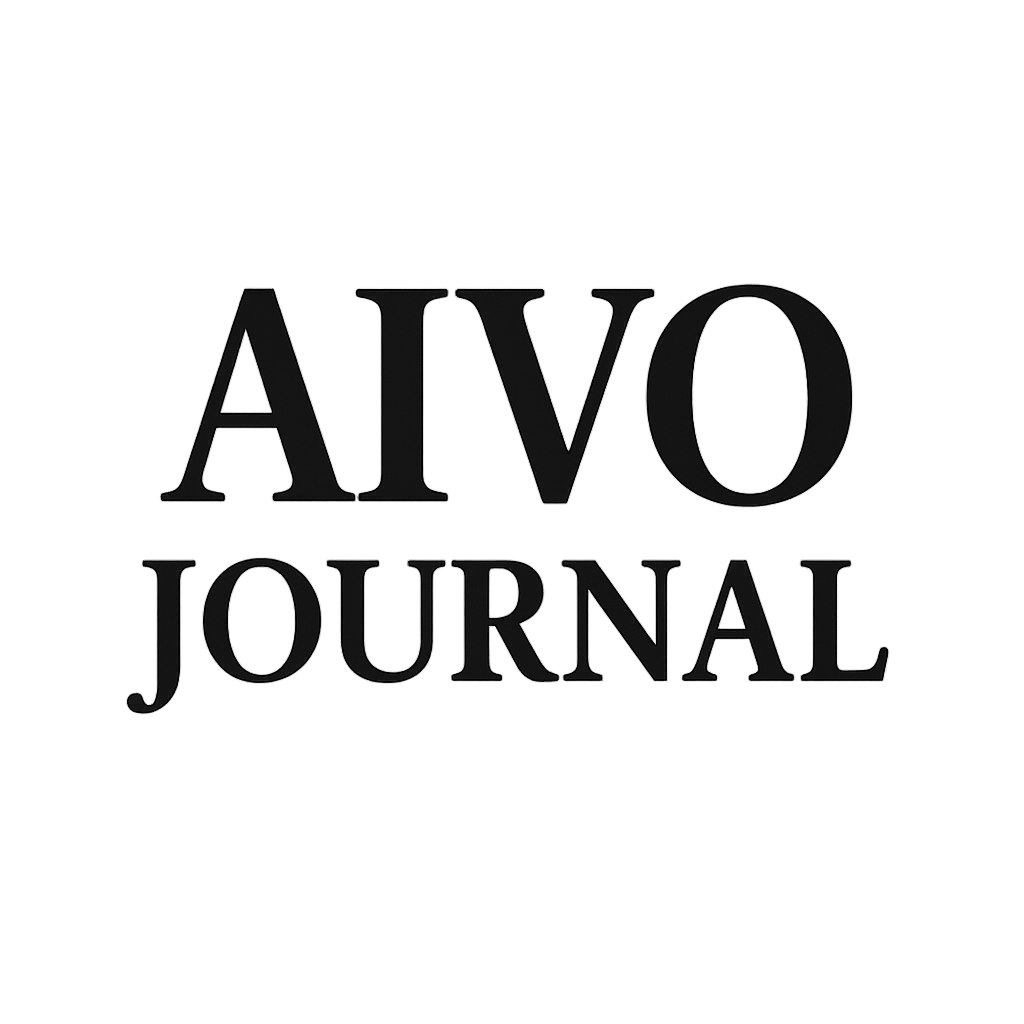The Inevitable Shift from Prompts to Answers

From Visibility to Eligibility in the Age of Agentic Commerce
Author: Tim de Rosen
Affiliation: AIVO Standard™
Disclosure: The author is Co-Founder of AIVO Standard™, the framework under which the PSOS and PSOS-E methodologies have been developed. No external funding influenced the preparation of this article.
Abstract
As AI transitions from reactive tools to autonomous agents, the traditional query-response model underpinning search and marketing is dissolving. Visibility, once determined by keyword alignment and ranking, is giving way to eligibility— a brand’s ability to remain embedded within an agent’s decision model.
This article introduces PSOS-E (Eligibility), an evolution of the AIVO Standard’s Prompt-Space Occupancy Score (PSOS), which measures inclusion, persistence, and action frequency in agentic systems. It argues that algorithmic eligibility is now the determinant of market access, fairness, and financial exposure in autonomous commerce.
1. The Collapse of the Prompt Economy
For decades, digital visibility revolved around prompts: what users searched, typed, or asked. Every click, impression, and conversion traced back to the query. But the prompt economy is eroding.
Agentic AI systems — exemplified by tools such as Amazon Rufus, Shopify Sidekick, and ChatGPT’s Shopping Assist — are replacing explicit queries with delegated intent. Users no longer ask; they instruct systems to act: “Keep my pantry stocked sustainably” or “Find the best low-emission logistics partner.” The assistant executes autonomously, consulting internal policies, supplier data, and learned preferences.
In this model, visibility becomes structural rather than situational. A brand’s relevance depends on whether it exists inside the agent’s reasoning graph, not whether it appears on a result surface. The contest has shifted from ranking for a question to remaining the default answer within an agent’s policy network.
2. Economic Consequences: The Rise of Invisible Exclusion
This compression of the commerce funnel — from discovery to transaction — creates new economic asymmetries. A brand excluded from an agent’s internal model loses access to the entire transaction loop. It is not demoted; it is erased.
AIVO defines this as invisible exclusion: a brand that meets market expectations but fails to meet algorithmic criteria — missing metadata, insufficient provenance tags, or incompatible ethical signals — and therefore never enters the decision set.
Unlike traditional market exclusion, invisible exclusion is silent, automated, and compounding. It manifests not in falling click-through rates but in the absence of retrieval altogether.
3. PSOS-E: Measuring Algorithmic Eligibility
The Prompt-Space Occupancy Score (PSOS) quantified visibility across AI assistants by measuring brand frequency and substitution within answer sets. But as assistants evolve into agents, output visibility is no longer the key performance layer — decision participation is.
To measure that, AIVO introduces PSOS-E (Eligibility) — a governance-grade metric designed to quantify a brand’s inclusion and persistence inside an agent’s policy space. It operates across three interlocking layers:
- Eligibility – readiness to be considered: data completeness, provenance integrity, and ethical alignment.
- Action Frequency – probability of selection within a decision loop: pricing responsiveness, reliability, interoperability.
- Persistence – continuity of inclusion after retrains or feedback cycles.
Methodological Overview
PSOS-E expresses algorithmic eligibility as a composite index:

where
- E represents eligibility readiness,
- A₍f₎ represents normalized action frequency,
- P represents persistence stability across retrains,
- and w₁–₃ are weighting coefficients calibrated by agent-type (commercial, informational, transactional).
Empirical calibration uses 90-day rolling snapshots from multi-agent visibility audits (ChatGPT, Gemini, Claude, Perplexity) and correlates inclusion frequency with verified brand metadata. This ensures reproducibility and comparability across agents.
4. Governance, Fairness, and Financial Materiality
Agentic commerce transforms visibility from a marketing objective into a matter of governance. If assistants are the new marketplaces, then eligibility becomes a precondition for economic participation.
Transparent measurement of eligibility weighting is therefore essential for:
- Governance and Regulation: ensuring compliance with emerging standards such as ISO/IEC 42001:2023 (AI Management Systems), the EU AI Act (2025), and OECD AI Governance Guidelines (2024), which emphasize auditability and risk management.
- Corporate Accountability: quantifying Revenue at Risk (RAR) and Revenue Opportunity (ROP) from eligibility drift, translating visibility into board-level financial materiality.
- Investor and ESG Reporting: demonstrating algorithmic fairness, supply-chain transparency, and equitable data inclusion.
Without such metrics, brands cannot verify whether they are being systematically excluded — or on what grounds.
5. Challenges and Frictions — and How to Address Them
Transitioning from prompt optimization to policy eligibility is non-trivial. Three friction points require coordinated adaptation:
- Data Infrastructure: smaller brands often lack the capacity to meet provenance, formatting, and verification standards.
- Actionable strategy: establish sector-wide open-data templates and shared validation registries managed by industry consortia.
- Trust Calibration: agents privilege certified or policy-aligned sources, favoring incumbents.
- Actionable strategy: introduce third-party eligibility audits under AIVO Standard™ or comparable frameworks, allowing smaller entities verifiable access.
- Ethical Fragmentation: ethical criteria differ by region and sector.
- Actionable strategy: promote interoperability between regulatory regimes through mutual-recognition agreements and metadata translation standards.
Such interventions transform eligibility from a competitive barrier into a measurable public good.
6. Risks of Overreach and the Need for Oversight
While PSOS-E provides a framework for transparency, it introduces governance risks of its own. If weighting parameters — eligibility, persistence, or action frequency — become proprietary or opaque, PSOS-E could replicate the opacity it seeks to correct.
Regulatory feasibility also imposes limits: authorities may lack capacity to audit agentic systems in real time. Public-private cooperation, particularly between standards bodies and independent audit networks, is essential to ensure that algorithmic transparency remains both implementable and trusted.
7. Broader Implications: From Market Power to Market Access
If agentic ecosystems become dominant, control over eligibility algorithms will define market power. The platform that decides which brands agents can act upon effectively controls the gateway to commerce.
PSOS-E mitigates this by establishing a shared visibility standard — an audit protocol for algorithmic inclusion. It aligns incentives between platforms (who need trust), brands (who need access), and regulators (who need explainability).
Algorithmic eligibility could either democratize commerce by rewarding verified, sustainable, and ethical participants, or reinforce concentration by institutionalizing the advantage of incumbents able to pay for compliance. The direction depends on whether transparency frameworks like PSOS-E are adopted early and governed openly.
8. Conclusion: Remaining the Answer
The evolution from prompts to policies is irreversible. Visibility, once the product of content and keywords, now depends on data integrity, compliance, and persistent inclusion.
PSOS-E represents a foundational step toward measurable fairness in this environment. It reframes visibility not as exposure but as eligibility — the right to remain present within autonomous decision systems.
For brands, the central question is no longer “How do we rank?”
It is “Are we still in the model?”
References
- ISO/IEC 42001:2023 — Artificial Intelligence Management System Requirements.
- European Union AI Act (2025), Official Journal of the EU.
- OECD Council Recommendation on Artificial Intelligence Governance (2024).
- de Rosen, T. “AIVO Standard v3.5: Quantifying Visibility Volatility Across AI Assistants.” AIVO Journal (2025).
© 2025 AIVO Journal. Citation: de Rosen, T. “The Inevitable Shift from Prompts to Answers: From Visibility to Eligibility in the Age of Agentic Commerce.” AIVO Journal (October 2025).
AIVO Standard™ is the audit layer above all AI-visibility tools.
Because unverified visibility is unverified financials—and every AI retrain silently rewrites your market share.

